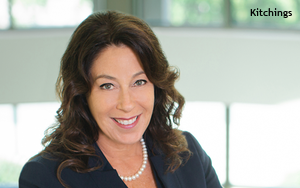
Cotton Incorporated has been
around the textile block a few times. Its Seal of Cotton first burst on the scene during the Nixon era, when a passion for polyester had devoured cotton’s share of the world textile market.
Thanks to decades of re-inventing “The fabric of our lives,” the organization turned a generic commodity into a fixture in apparel marketing, used by 950 brands in 70 countries. Kim
Kitchings, senior vice president of consumer marketing, talks to Marketing Daily about what’s ahead.
Marketing Daily: Many are familiar with your ads but not the funding.
How does it work?
Kim Kitchings: We are a not-for-profit company, funded about 50% by U.S. cotton growers, the rest by brands and retailers that import non-U.S. cotton.
Marketing Daily: In the 1980s, cotton’s big message was breathability and comfort. Now, especially for younger consumers, cotton can evoke bad things, like pesticides and runoff, or
human rights, like the plight of the Uyghurs in China. How do you address those changing perceptions?
advertisement
advertisement
Kitchings: I’ve been here for 28 years and have been in consumers' homes in
India, China, and New Jersey, watching them do laundry and talking to them. When you ask them to name a fiber, cotton is No. 1. The words they use to describe it are soft, breathable, natural --
positive things. We don't hear about those negatives until we start probing. Most consumers don't think about that.
And we’ve built an emotional connection through the 1980s, especially
the ads with Aaron Neville singing “The Fabric of Our Lives.”
Marketing Daily: Consumers are more aware of how complicated choices are. Every decision has some environmental
impact. How does your marketing reflect that complexity?
Kitchings: When we speak to consumers, we want to talk to them about human truths, what resonates with them and what matters.
One of the most important things is comfort, whether a cotton towel, a cotton blazer or a hoodie. Coming out of the pandemic, simplicity is more important. There’s a nod to nostalgia, and people
want someone they trust and who is authentic. We’re doing some advertising in the gaming area right now, and while they may not be thinking what they're gaming in, they're wearing sweatpants and
denim. We remind them of that.
Marketing Daily: How durable do you think the brand and logo are?
Kitchings: We do a seal study every few years to see how it is positioned
compared to other fiber logos. The Seal of Cotton is recognized by 78% of consumers, and known two times more than the closest fiber logos and 10 times more than the least known. Our biggest
competitor, polyester, is non-branded. But other logos include brands like Lycra, Wool and Tencel.

Marketing Daily: How much buying preference is driven
by the seal?
Kitchings: Four out of five consumers tell us that the brand represents quality and is something they want to purchase. They see it as authentic, trustworthy and better for
the environment. That environmental consideration has increased significantly over the past eight years, which has to do with heightened awareness about the environment and our marketing.
Marketing Daily: Gen Z cares a great deal about sustainability. They buy lots of used clothing and have strong opinions on everything from fast fashion to organic cotton. How do you reach
them?
Kitchings: We’re big on social media, reminding people to check labels. And cotton garments last a year and a half longer in your closet than garments made from synthetics.
So they can be a wardrobe staple, timeless. Classic. And it appeals to Gen Z because cotton is more sustainable. We’re in the midst of a program with Aeropostale, for example, called Dripped in
Cotton.
Marketing Daily: Organic cotton has become more popular, with even mass brands, like Carter’s and Burt’s Bees, using it. But organic represents just a tiny
percentage, right?
Kitchings: Yes, about 1% in the U.S. and abroad. Some brands can do 100% organic. Others do blends to keep price points lower.
Marketing Daily: Some
brands, like Levi’s, now go to great lengths to explain their textile process, talking about efforts to minimize environmental impact. Do you expect that to continue?
Kitchings:
Yes. Brands and retailers are striving for continuous improvement. There’s also more communication -- from us, too -- about ways consumers can help, like washing clothes less often and using
cold water. And there’s more interest in recycling, like our Blue Jeans Go Green program, which we started 16 years ago. We’ve worked with more than 500 brands and retailers and just
started a program for all-cotton items in the U.K. It’s another way we try to keep the seal relevant.
Marketing Daily: Your advertising account is in review right now.
What’s ahead?
Kitchings: We'll keep growing with younger consumers and haven’t forgotten boomers. They were our original customers. We’ll do more experiential events,
brand partnerships and recycling programs. And find better ways to communicate about sustainability and why it matters.